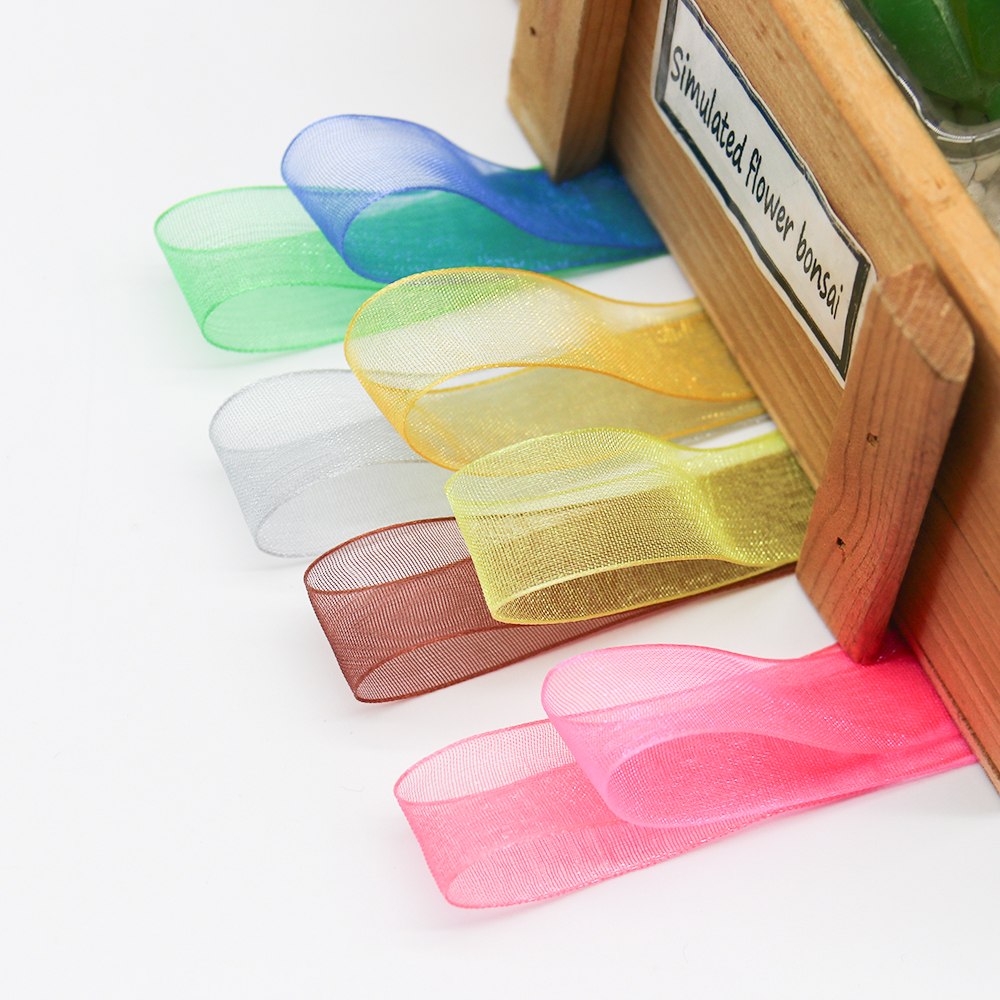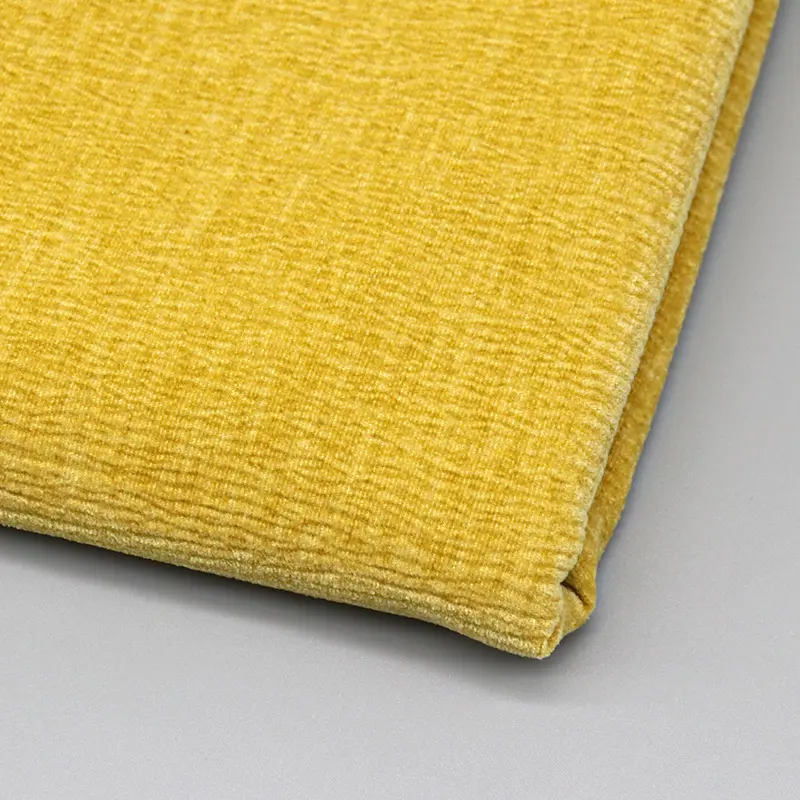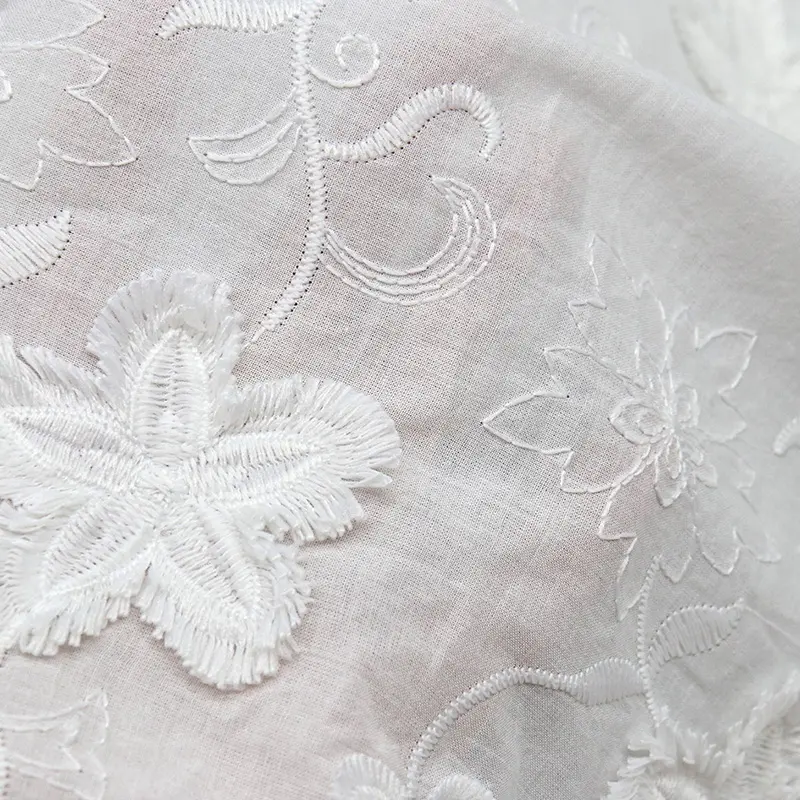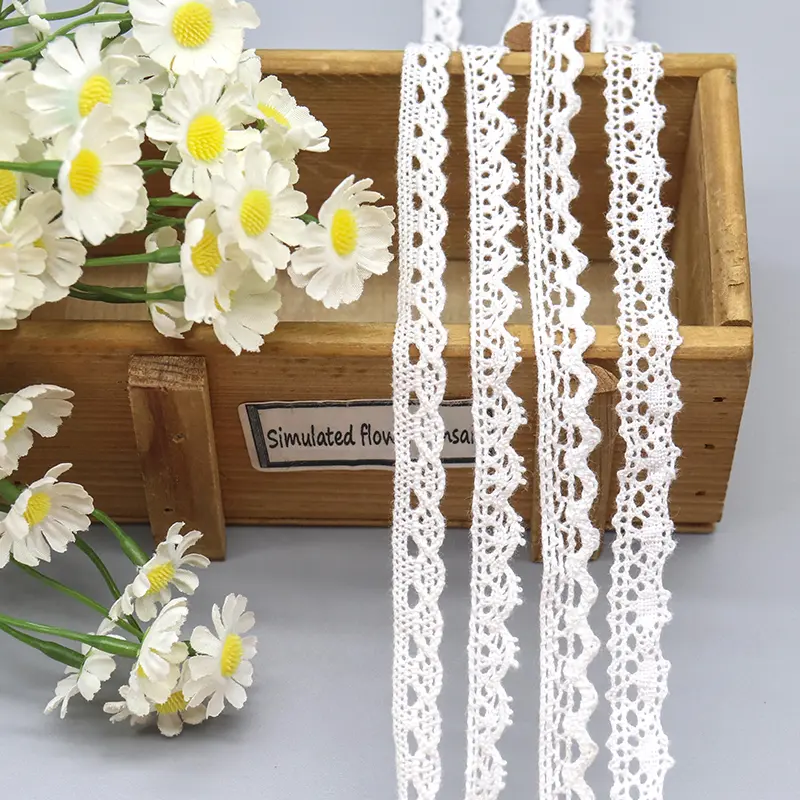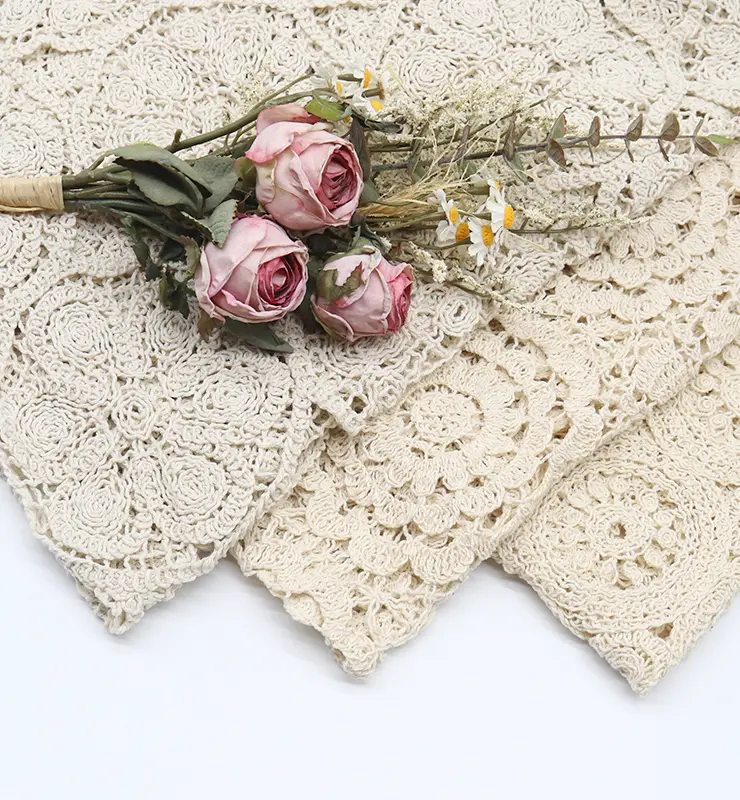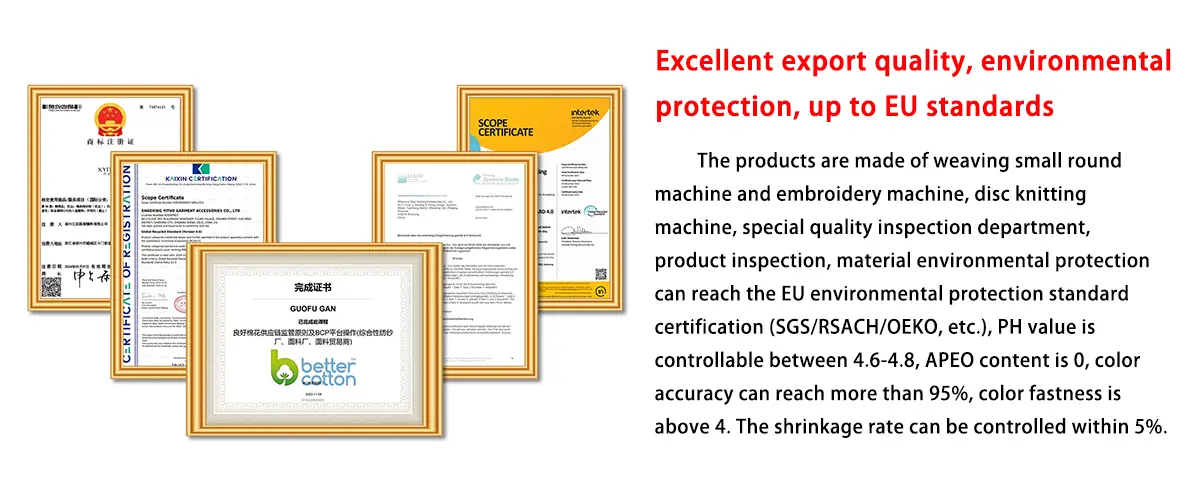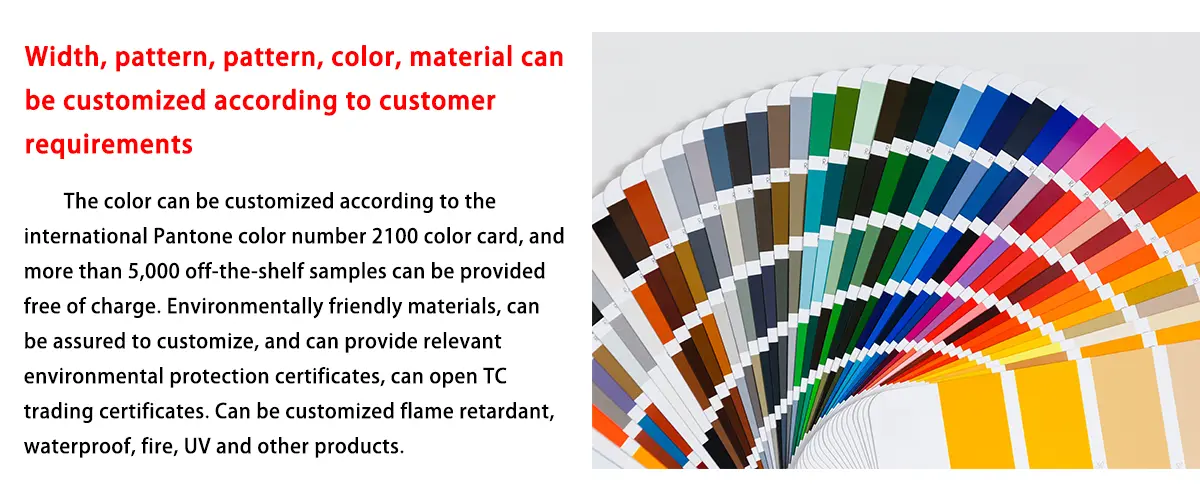What Is Cotton Embroidery Fabric
What Is Cotton Embroidery Fabric?
Definition and Key Features
Cotton embroidery fabric is a type of material made from 100% cotton fibers, specifically designed to support embroidery work. It’s known for its smooth surface and even weave, which makes it easy for you to create intricate designs. The fabric feels soft yet sturdy, giving you the perfect balance of comfort and durability.
One of its standout features is its breathability. This means your projects won’t feel heavy or stiff, even if you’re working on larger pieces. Plus, cotton absorbs dye well, so you can find it in a variety of colors to match your creative vision. Whether you’re stitching a floral pattern or a bold geometric design, this fabric provides a reliable base for your work.
Differences from Other Fabrics
You might wonder how cotton embroidery fabric compares to other materials like polyester or silk. The biggest difference lies in its texture and weave. Cotton has a natural, slightly textured feel, while synthetic fabrics like polyester can feel slippery or too smooth. This texture helps your needle glide through the fabric without snagging.
Unlike silk, which can be delicate and tricky to handle, cotton is forgiving. It doesn’t fray as easily, and it holds stitches firmly in place. You’ll also notice that cotton is more breathable than synthetic options, making it a better choice for projects like clothing or home décor.
Why Cotton Is Perfect for Embroidery
Cotton embroidery fabric is a favorite for a reason—it’s versatile, durable, and easy to work with. Its even weave ensures your stitches look neat and uniform, even if you’re just starting out. The fabric’s strength means it can handle dense stitching or heavy thread without tearing.
Another reason to love cotton is its adaptability. You can use it for everything from small DIY crafts to professional embroidery projects. Plus, it’s widely available and budget-friendly, so you don’t have to break the bank to get started. If you’re looking for a fabric that makes embroidery enjoyable and stress-free, cotton is the way to go.
Benefits of Cotton Embroidery Fabric
Durability and Longevity
When you choose cotton embroidery fabric, you’re investing in a material that lasts. Cotton is naturally strong, so it holds up well even after repeated use or washing. Your embroidery projects will stay intact for years, whether they’re decorative pieces or functional items like pillowcases or tote bags.
The fabric’s durability also means it can handle dense stitching or intricate designs without tearing. You don’t have to worry about your hard work unraveling over time. Plus, cotton resists wear and tear better than many synthetic fabrics. If you want your creations to stand the test of time, this fabric is a reliable choice.
Versatility for Various Projects
Cotton embroidery fabric works for almost any project you can imagine. From home décor like curtains and table runners to personalized gifts like handkerchiefs or wall art, it’s a versatile option. You can even use it for clothing embellishments, adding a unique touch to shirts, dresses, or jackets.
Its adaptability doesn’t stop there. Cotton comes in different weights and textures, so you can pick the perfect type for your project. Whether you’re creating something simple or tackling a complex design, this fabric makes it easy to bring your ideas to life.
Beginner-Friendly Material
If you’re new to embroidery, cotton embroidery fabric is your best friend. Its even weave and smooth surface make it easy to work with, even if you’re still learning the basics. You’ll find that your needle glides through the material effortlessly, helping you focus on your stitches instead of struggling with the fabric.
Mistakes are part of the learning process, and cotton is forgiving. It’s sturdy enough to handle rework if you need to remove stitches and start over. Plus, it’s widely available and affordable, so you can practice without worrying about wasting expensive materials. For beginners, this fabric offers a stress-free way to dive into embroidery.
Eco-Friendly and Sustainable Choice
If you care about the environment, cotton embroidery fabric is a fantastic choice. Cotton is a natural fiber, which means it comes from plants instead of being made in a lab. This makes it biodegradable, so it won’t sit in a landfill for years like synthetic materials. When you use cotton, you’re choosing a fabric that’s kinder to the planet.
Another great thing about cotton is how sustainable it can be. Many cotton farms now use eco-friendly practices, like reducing water waste and avoiding harmful pesticides. Organic cotton is even better since it’s grown without chemicals that can harm the soil or water. By picking organic cotton embroidery fabric, you’re supporting farming methods that protect the earth.
You’ll also love how durable cotton is. Because it lasts a long time, you won’t need to replace your projects as often. This reduces waste and helps you get more use out of your creations. Whether you’re making a reusable tote bag or a decorative pillow, cotton embroidery fabric ensures your work stays beautiful and functional for years.
Recycling is another bonus. Cotton scraps from your embroidery projects can be repurposed into new items, like patchwork quilts or small crafts. Instead of throwing away leftover pieces, you can give them a second life. It’s a simple way to reduce waste and get creative at the same time.
Choosing cotton embroidery fabric isn’t just good for your projects—it’s good for the planet too. You get to enjoy a high-quality material while making a positive impact on the environment. It’s a win-win for you and the earth!
Uses of Cotton Embroidery Fabric

Home Décor and Accessories
Cotton embroidery fabric is perfect for sprucing up your home. You can use it to create stunning pillowcases, table runners, or even wall hangings. Its sturdy yet soft texture makes it ideal for decorative items that need to last. Imagine stitching a vibrant floral design on a throw pillow or crafting a custom tablecloth for special occasions. These small touches can transform your space into something truly unique.
You’ll also love how easy it is to match cotton embroidery fabric with your existing décor. It comes in various colors and patterns, so you can find something that fits your style. Whether you prefer minimalist designs or bold, intricate patterns, this fabric helps you bring your vision to life.
Clothing and Fashion Embellishments
Want to add a personal touch to your wardrobe? Cotton embroidery fabric is a fantastic choice for clothing embellishments. You can stitch beautiful designs onto shirts, dresses, or even denim jackets. It’s a great way to make your outfits stand out and reflect your personality.
This fabric works well for both casual and formal wear. For example, you could embroider delicate patterns on a blouse for a chic look or create bold, colorful designs on a T-shirt for a fun vibe. The fabric’s durability ensures your stitches stay intact, even after multiple washes. Plus, it’s breathable, so your clothes remain comfortable to wear.
DIY and Craft Projects
If you enjoy crafting, cotton embroidery fabric opens up endless possibilities. You can use it for handmade gifts like bookmarks, tote bags, or ornaments. It’s also great for creating unique art pieces, such as embroidered hoops or framed designs.
This fabric is beginner-friendly, so you don’t need to be an expert to get started. You can experiment with different stitches and patterns without worrying about ruining the material. Plus, leftover scraps can be repurposed for smaller projects, making it a budget-friendly option for crafters.
Whether you’re decorating your home, updating your wardrobe, or diving into DIY crafts, cotton embroidery fabric is a versatile and reliable choice.
Professional Embroidery Applications
Cotton embroidery fabric isn’t just for hobbyists or DIY enthusiasts. It’s also a staple in professional embroidery work. If you’ve ever admired the intricate designs on high-end clothing, luxury linens, or branded merchandise, chances are they were created using this versatile fabric.
In the fashion industry, professionals rely on cotton embroidery fabric to craft stunning embellishments. Designers use it to add intricate details to dresses, blouses, and even wedding gowns. The fabric’s even weave and durability make it ideal for creating precise, eye-catching patterns that elevate any garment. It’s also breathable, so the finished pieces remain comfortable to wear.
Businesses also turn to cotton embroidery fabric for custom branding. Think of embroidered logos on uniforms, caps, or tote bags. Cotton’s strength ensures these designs hold up under frequent use and washing. Plus, its smooth surface allows for clean, professional-looking stitches that represent a brand’s image perfectly.
In the world of interior design, professionals use this fabric to create bespoke home décor. Custom embroidered curtains, tablecloths, and cushion covers add a touch of elegance to any space. Cotton’s ability to absorb dye ensures vibrant colors that make these pieces stand out.
Even artists and artisans use cotton embroidery fabric for gallery-worthy creations. From embroidered wall art to intricate tapestries, this fabric provides a reliable canvas for their masterpieces. Its versatility and quality make it a favorite among professionals who demand the best.
Whether it’s fashion, branding, or art, cotton embroidery fabric plays a key role in professional applications. Its durability, adaptability, and polished finish make it the go-to choice for experts in various fields.
Types of Cotton Embroidery Fabric

Plain Cotton
Plain cotton is the most common type of cotton embroidery fabric. It’s simple, versatile, and easy to work with, making it a favorite for beginners and experienced embroiderers alike. The smooth surface and even weave of plain cotton allow your stitches to look clean and precise. You’ll find it in various weights, so you can choose the one that best suits your project.
This fabric works well for almost anything. Whether you’re creating a decorative wall hanging, a personalized gift, or a piece of clothing, plain cotton gives you a reliable base. It’s also affordable and widely available, so you won’t have trouble finding it at your local craft store or online. If you’re just starting out, plain cotton is a great choice to practice your skills.
Cotton Canvas
Cotton canvas is a heavier, sturdier option for embroidery. Its thick texture makes it perfect for projects that need extra durability, like tote bags, upholstery, or outdoor décor. The fabric’s strength allows it to handle dense stitching and heavier threads without tearing or stretching.
You’ll love how cotton canvas holds its shape. This makes it ideal for bold, structured designs that stand out. While it’s not as soft as plain cotton, its durability more than makes up for it. If you’re working on a project that requires a strong foundation, cotton canvas is the way to go.
Cotton Muslin
Cotton muslin is a lightweight and breathable fabric that’s perfect for delicate embroidery projects. Its soft texture and loose weave make it easy to work with, especially for designs that require fine details. You’ll often see muslin used for handkerchiefs, baby clothes, or decorative pieces like curtains.
One of the best things about muslin is its versatility. You can use it as a base fabric or layer it with other materials for a unique look. It’s also budget-friendly, so you can experiment with different techniques without worrying about the cost. If you’re looking for a fabric that’s light and airy, cotton muslin is a fantastic option.
Cotton Linen Blends
Cotton linen blends combine the best qualities of two natural fibers—cotton and linen. This fabric offers a unique texture that feels soft yet crisp, making it a favorite for embroidery projects that need a touch of elegance. If you’re looking for something that’s both durable and breathable, this blend is a fantastic option.
One of the standout features of cotton linen blends is their strength. Linen fibers add extra durability to the softness of cotton, so your projects can handle frequent use without wearing out. This makes it perfect for items like tablecloths, cushion covers, or even tote bags. You’ll also love how well this fabric holds its shape, which is great for designs that need a structured look.
The texture of cotton linen blends is another reason to try it. The fabric has a slightly rougher surface compared to plain cotton, giving your embroidery a more textured and dimensional appearance. This works beautifully for bold patterns or rustic designs. Plus, the natural fibers absorb dye well, so you can find this fabric in a variety of rich colors to match your creative vision.
Working with cotton linen blends is straightforward, even if you’re new to embroidery. The fabric’s weave is tight enough to hold stitches securely but loose enough to let your needle glide through easily. It’s a forgiving material, so you can experiment with different techniques without frustration.
If you want a fabric that combines sophistication with practicality, cotton linen blends are worth exploring. They bring out the best in your embroidery while offering a reliable base for your creativity. Whether you’re crafting home décor or wearable art, this fabric won’t disappoint.
Caring for Cotton Embroidery Fabric
Washing and Cleaning Tips
Taking care of your cotton embroidery fabric starts with proper washing. Always check if the fabric is pre-washed before you begin your project. Pre-washing helps prevent shrinkage later. If you’re dealing with finished embroidery, handwashing is the safest option. Use cold water and a mild detergent to protect the fabric and your stitches. Gently swish the fabric in the water without scrubbing or wringing it.
For stubborn stains, try spot cleaning. Dab the area with a soft cloth soaked in a mix of water and mild soap. Avoid harsh chemicals like bleach, as they can weaken the fibers and fade your embroidery. If you’re using a washing machine, choose a delicate cycle and place the fabric in a mesh laundry bag for extra protection.
Tip: Test your thread colors for colorfastness before washing. This ensures they won’t bleed and ruin your design.
Drying and Ironing Guidelines
Drying your cotton embroidery fabric correctly is just as important as washing it. Lay the fabric flat on a clean towel and gently roll it up to remove excess water. Then, unroll it and let it air dry on a flat surface. Avoid hanging it, as this can stretch the fabric and distort your stitches.
When it’s time to iron, turn the fabric inside out or place a pressing cloth over the embroidery. Use a low to medium heat setting to avoid scorching the fabric or threads. Press gently without dragging the iron across the surface. This keeps your stitches intact and your fabric smooth.
Note: Never iron directly on the embroidery. It can flatten your stitches and ruin the texture of your design.
Proper Storage Techniques
Storing your cotton embroidery fabric the right way keeps it looking fresh and beautiful. Always clean and dry the fabric before putting it away. Fold it neatly and store it in a cool, dry place away from direct sunlight. Sunlight can fade the colors over time.
If you’re storing unfinished projects, consider using acid-free tissue paper to separate layers. This prevents creases and protects the fabric from discoloration. For long-term storage, keep your fabric in a breathable container like a cotton bag or a plastic bin with ventilation holes. Avoid airtight containers, as they can trap moisture and lead to mildew.
Pro Tip: Add a lavender sachet or cedar block to your storage area. It keeps pests like moths away while leaving a pleasant scent.
Caring for your cotton embroidery fabric doesn’t have to be complicated. With these simple steps, you can keep your projects looking vibrant and lasting for years to come.
Preventing Wear and Tear
Keeping your cotton embroidery fabric in great shape doesn’t have to be a challenge. With a few simple habits, you can protect your projects from damage and ensure they stay beautiful for years. Here’s how you can prevent wear and tear:
-
Handle with Care
Always treat your fabric gently, especially when working on your embroidery. Avoid pulling the thread too tightly, as this can strain the fabric and distort your stitches. If you’re using a hoop, make sure it’s not clamped too tightly to prevent leaving marks or stretching the material. -
Rotate Your Projects
If you’re working on a large piece, rotate your fabric regularly. This prevents overhandling one area, which can weaken the fibers. It also helps distribute any tension evenly, keeping your fabric in top condition. -
Protect from Friction
Friction is one of the biggest culprits behind wear and tear. Avoid rubbing the fabric against rough surfaces or sharp objects. If you’re storing your project in a bag, choose a soft, padded one to prevent accidental snags. -
Limit Sun Exposure
Prolonged exposure to sunlight can fade your fabric and embroidery threads. When you’re not working on your project, store it in a shaded area or cover it with a cloth to block out the light. -
Use Reinforcements
For items like tote bags or clothing that see frequent use, consider reinforcing the fabric. Adding a backing layer or interfacing can provide extra support and reduce stress on the stitches.
Tip: If you notice loose threads or minor damage, fix them right away. Small repairs can prevent bigger problems down the line.
By following these steps, you’ll keep your cotton embroidery fabric looking fresh and vibrant. A little care goes a long way in preserving your hard work! 😊
Choosing the Right Cotton Embroidery Fabric
Matching Fabric to Your Project
Choosing the right fabric starts with understanding your project. Are you working on a decorative wall hanging, a piece of clothing, or a functional item like a tote bag? Each project has unique needs, and the fabric you pick should match those requirements. For example, plain cotton works well for detailed designs on home décor, while cotton canvas is better for sturdy items like bags or upholstery.
Think about the design too. If your embroidery involves intricate patterns, go for a fabric with a smooth surface and even weave. This ensures your stitches look clean and precise. On the other hand, if you’re aiming for a rustic or textured look, a cotton linen blend might be the perfect choice. Matching the fabric to your project helps you achieve the best results.
Considering Weight and Texture
Fabric weight and texture play a big role in how your embroidery turns out. Lightweight fabrics like cotton muslin are great for delicate designs, while heavier options like cotton canvas can handle bold, dense stitching. The texture also matters. A smooth fabric makes it easier to create neat stitches, while a textured one adds depth and character to your work.
Feel the fabric before you buy it. Does it feel soft and flexible, or is it stiff and coarse? Pick a texture that complements your design and makes stitching enjoyable. The right weight and texture can make all the difference in your final piece.
Evaluating Thread Count and Quality
Thread count refers to the number of threads woven into one square inch of fabric. A higher thread count means a tighter weave, which is ideal for detailed embroidery. Lower thread counts, on the other hand, are better for larger, bolder designs.
Quality is just as important. Look for fabrics that feel durable and don’t fray easily. High-quality cotton embroidery fabric ensures your stitches stay secure and your project lasts longer. Always inspect the fabric closely to make sure it meets your standards. A little attention to thread count and quality goes a long way in creating beautiful embroidery.
Budget-Friendly Options
You don’t have to spend a fortune to get high-quality cotton embroidery fabric. With a little planning and creativity, you can find options that fit your budget while still delivering great results. Here are some tips to help you save money:
-
Shop Sales and Discounts
Keep an eye out for sales at your local craft stores or online retailers. Many stores offer discounts during holidays or end-of-season clearances. Signing up for newsletters can also give you access to exclusive deals and coupons. -
Buy in Bulk
If you’re working on multiple projects, buying fabric in bulk can save you money. Wholesale suppliers often offer lower prices per yard compared to retail stores. Plus, having extra fabric on hand means you’re always ready for your next project. -
Repurpose Old Cotton Items
Got an old cotton shirt or pillowcase lying around? Repurpose it into embroidery fabric! This not only saves money but also gives your project a unique, upcycled touch. Look for items with smooth, even weaves for the best results. -
Check Thrift Stores
Thrift stores and secondhand shops can be treasure troves for affordable fabric. You might find cotton curtains, tablecloths, or sheets that can be cut and used for embroidery. It’s an eco-friendly and budget-friendly option. -
Compare Online Options
Online marketplaces like Etsy or Amazon often have competitive prices. Compare different sellers to find the best deals. Don’t forget to read reviews to ensure you’re getting good quality fabric.
Tip: Don’t compromise on quality just to save a few bucks. Low-quality fabric can make embroidery frustrating and may not last long. Always balance affordability with durability.
Saving money on cotton embroidery fabric doesn’t mean sacrificing creativity. With these tips, you can stretch your budget and still create stunning projects. Happy stitching! 😊
Cotton embroidery fabric truly stands out as a versatile and reliable choice for all your creative projects. Its durability, eco-friendliness, and beginner-friendly nature make it a favorite among embroidery enthusiasts. Whether you’re crafting home décor, personalizing clothing, or diving into DIY crafts, this fabric adapts beautifully to your needs.
Tip: Don’t hesitate to try different types of cotton fabrics. Each one offers unique textures and possibilities for your designs.
So, grab your needle and thread, and let your imagination run wild. Cotton embroidery fabric is ready to bring your ideas to life! 😊


